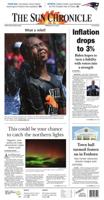Fifteen or so years ago, it was easy for baseball fans to imagine the superstars of that era someday landing in Cooperstown, NY, for permanent enshrinement in the National Baseball Hall of Fame. It seemed even back then that players like Manny Ramirez, Roger Clemens, Alex Rodriguez, and Barry Bonds were seemingly shoo-ins at the conclusions of their MLB careers, and even borderline candidates like Andy Pettitte, Gary Sheffield, and Curt Schilling were on the right trajectories for enshrinement.
Then MLB’s Mitchell Report came out in Dec. 2007, and it revealed that numerous major leaguers had engaged in either direct doping or purchases of performance-enhancing drugs, and that forever tarnished the future candidacies of Clemens, Bonds, and Pettitte. Later, Ramirez and A-Rod were suspended for lengthy periods for positive drug tests after MLB had implemented regular drug testing.
(It is worth noting that the Red Sox’ David Ortiz, who was elected a year ago and was inducted in July, was not mentioned in the Mitchell Report, but the NY Times wrote in 2009 that Ortiz and his teammate, Ramirez, were later alleged to have used performance-enhancing substances during the 2003 season. Ortiz has denied using and has pretty much been exonerated by current commissioner Rob Manfred, leading to his first-year selection by the voters.)
Now here we are in the early days of 2023, and Clemens, Bonds, Sheffield, and Schilling have seen their 10-year windows of getting elected by the BBWAA evaporate, and the chances of A-Rod, Ramirez and Pettitte are also in dire straits, given that each received totals of 35.7 percent, 33.2 percent, and 17 percent, respectively, in the latest voting tally issued earlier this week, where 75 percent is needed for enshrinement.
So instead of those clear-cut (but tainted) superstars polishing up their plaques in Cooperstown, or preparing their speeches for their July inductions, we have Phillies third baseman Scott Rolen, who was elected with 76.3 percent of the vote, and multi-traveled Fred McGriff, who was unanimously selected by the 16-member Contemporary Baseball Era committee in December. Players considered eligible by that committee were those deemed with making “primary contributions to the game after 1980” and had to receive 75 percent of the vote to be elected; notably, Schilling (who was never PED-tainted, just Twitter-compromised), Clemens, and Bonds were up for selection by the CBE committee, and none of them was chosen.
Growing up a baseball fan and following the sport closely, it sure does seem to me that lately the Hall, through its voting policies and its various veterans committees that select players after their voting eligibility has expired, is more likely to select and induct pretty good and perhaps really good players, but few that real baseball fans would have considered Hall-worthy during their careers.
Rolen is a good example; he’s a career .281 hitter who played more than 142 games in only five of his 17 big-league seasons. He made it into the top 10 of MVP voting in only one season, and in the 2004 World Series, Rolen went 0-for-15 when the Cardinals were swept by the Red Sox. Meanwhile, McGriff, playfully nicknamed “The Crime Dog,” was known for his powerful bat and sure glove at first base and spent his MLB career with six different clubs, collecting 2,490 hits to go along with 1,550 RBI and a .284 career average.
Other recent inductees include Jeff Bagwell, Jim Thome, Mike Mussina, Craig Biggio, Edgar Martinez, Barry Larkin, and probably the least-deserving Hall-of-Famer in decades, Harold Baines, who was selected by a veterans committee stocked with several voters who had either played with Baines or had him as part of their team in management capacities. Baines’s career home run total of 384 is just 65th all-time, behind guys like Aramis Ramirez, Jim Edmonds, and Joe Carter, as well as many more who haven’t made the Cooperstown cut. Baines was a six-time All-Star, but didn’t earn much more in the way of accolades; his highest MVP finish was ninth, in 1985 with the White Sox, when he hit .309 but registered an unexceptional 118 OPS+ in 693 plate appearances.
None of the guys in the previous paragraphs was viewed as anything other than a very good player during their careers, but all are now in the Hall while established and larger-than-life superstars like Clemens, Bonds, A-Rod, and Manny are not — mostly of their own doing, of course, but what kind of Hall of Fame do we have when Harold Baines, Scott Rolen, Fred McGriff, Mike Mussina have plaques in the same hallowed hallway as the likes of Ty Cobb, Babe Ruth, Mickey Mantle, Yogi Berra, Cy Young, Joe DiMaggio, Hank Aaron, and Jackie Robinson?
Perhaps the players selected in recent years have been voted in not because they were actually charismatic, clutch, and playoff heroes and/or winners, but because the nerds in every MLB team’s scouting department have elevated analytics and number-crunching ahead of the on-the-field qualities that make players revered by their teams’ fans. In time, this kind of cold-hearted analytical approach has to seep down to the voting members of the BBWAA, who have to justify their votes with hard, cold situational numbers rather than what their eyes are telling them.
Fortunately in the next few years, BBWAA voters will have new and deserving candidates such as Joe Mauer, Adrian Beltre, Ichiro Suzuki, and Albert Pujols to consider, while down the road, we can look forward to more actual superstars inducted in their first few years of eligibility — no-doubters like Mike Trout, Bryce Harper, Miguel Cabrera, Justin Verlander, and Max Scherzer.
In the meantime, who’s joining me for a blazin’ good time in Cooperstown this summer to celebrate the Crime Dog and Scott Rolen, he of the .220 postseason batting average (31-for-141)?
Buehler? Buehler?










